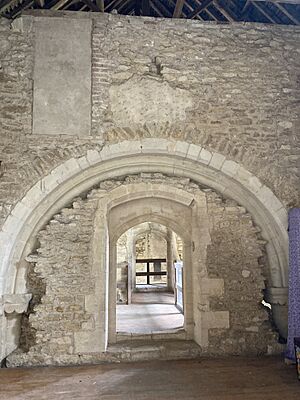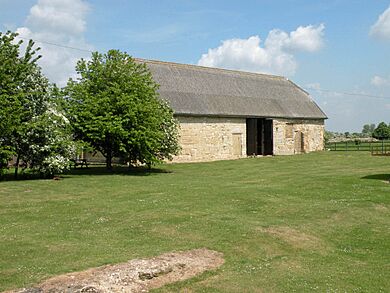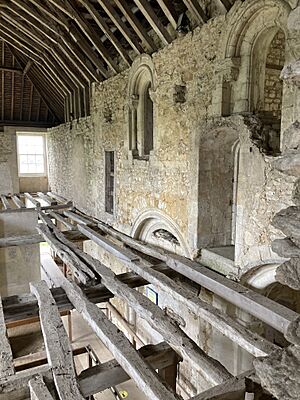Denny Abbey facts for kids
Quick facts for kids Denny Abbey |
|
|---|---|
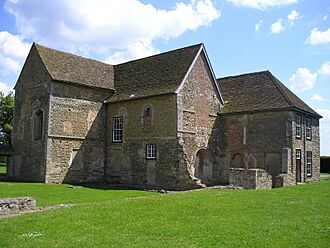
The main remnants of the abbey buildings, showing the door to the Templar church at centre, and the priest's house at right
|
|
| General information | |
| Type | Abbey |
| Location | Waterbeach |
| Town or city | Waterbeach |
| Country | England |
| Coordinates | 52°15′41″N 00°11′26″E / 52.26139°N 0.19056°E |
| Elevation | 6m |
| References | |
| https://explore.osmaps.com/ | |
Denny Abbey is an old abbey near Waterbeach, about 6 miles (10 km) north of Cambridge in Cambridgeshire, England. Today, it is known as the Farmland Museum and Denny Abbey.
This special place was once home to three different groups of religious people over many years. It is now a scheduled ancient monument, which means it's a very important historical site protected by law. Some of the original church and dining hall buildings are still standing and are considered Grade I listed buildings, meaning they are of exceptional historical interest. There's also a barn on the site, built in the 1600s, using stones from the old abbey.
The area where Denny Abbey stands has been used by farmers since the time of the Romans. In 1086, a famous book called the Domesday Book recorded that the land belonged to Edith the Fair, who was married to King Harold. Later, it was owned by a lord from Brittany. The name "Denny" first appeared in records around 1176 and is thought to mean "Danes' Island."
Contents
Who Lived at Denny Abbey?
Benedictine Monks: The First Residents
In the 1150s, a group of Benedictine monks moved to Denny. They came from a nearby monastery that was often flooded. These monks built a church and monastery, which they called Denny Priory, and it opened in 1159. Today, only parts of the original church, like the central crossing and side sections, remain. In 1169, the monks moved back to Ely, and the site was given to the Knights Templar.
Knights Templar: A Hospital for Knights
The Knights Templar were a famous group of warrior monks. When they took over Denny, they added new parts to the buildings, including a large arched doorway and a dining hall. By the mid-1200s, Denny became a hospital where sick Knights Templar could recover.
However, the Knights Templar eventually lost their power. In 1308, King Edward II ordered all members of the Order to be arrested and imprisoned. Their property, including Denny, was taken by the King. Denny was then given to another group, the Knights Hospitaller, but they didn't do much with it. So, in 1324, the King took it back again.
Poor Clares: Nuns and a Countess
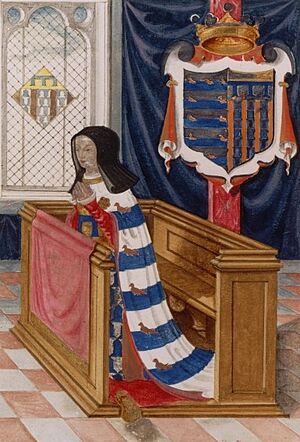
In 1327, King Edward III gave the Priory to a young widow named Marie de St Pol. She was the Countess of Pembroke and is famous for starting Pembroke College, Cambridge. Countess Marie changed the old abbey church into her own living quarters. She then had a new church built and gave the rest of the priory to the Franciscan Poor Clares, a group of nuns. These nuns moved from their own monastery, which also suffered from floods.
During this time, the priory grew. It had comfortable rooms for the Countess, who never became a nun herself, and simpler rooms for the Poor Clares. It was during this period that the priory started to be called Denny Abbey, even though the nuns of this order usually don't use that term. The Countess of Pembroke passed away in 1377 and was buried at Denny Abbey, but her exact burial spot is now unknown.
Denny Abbey After the Monasteries
Becoming a Farmhouse
In 1536, during a time known as the Dissolution of the Monasteries, Denny Abbey was closed down. The King took it over once more. The last of the nuns left within two years. The Countess's old lodge was kept and turned into a farmhouse, and the dining hall became a barn. However, the main part of the church was pulled down. In 1628, the abbey became privately owned.
Records show that in 1663, the Abbey estate was valued at a modest amount. However, by 1686, a man named Joseph Kettle had increased its value significantly. He might have been responsible for the big changes made to the farm buildings in the late 1600s.
In 1928, Pembroke College, Cambridge, which Countess Marie de St Pol had founded, bought the site.
Denny Abbey Today: A Museum for Everyone
The abbey, the nuns' dining hall, and the land around them continued to be a farm until 1947. Then, they were leased to the Ministry of Works, which later passed them to English Heritage.
The abbey was partly restored in the 1960s and is now open to the public. It is managed by the Farmland Museum, which works with English Heritage.
The Farmland Museum opened in 1997. It has a shop, a café, and an education center that offers courses for local schools. Old farm buildings, including the 17th-century barn, have been turned into exhibits about local history and farming. You can see a 1940s farm worker's cottage, a 1930s village shop, and displays about old crafts and skills. Many of the old farm tools and machines came from a museum in nearby Haddenham that closed. At Haddenham, interviews were recorded in the 1970s with local farmers, sharing their stories from the early 1900s.
The entire site, known as The Farmland Museum and Denny Abbey, is open from April to October. They also have special event days throughout the year.
Other Interesting Places to See
- Isleham Priory Church, another old priory in Cambridgeshire that was once owned by Pembroke College, Cambridge. It is now looked after by English Heritage.
- Chatteris Abbey, a similar building in Cambridgeshire, which has since been taken down.


